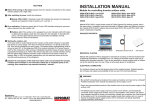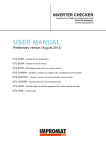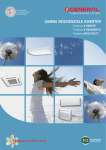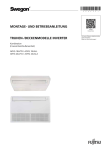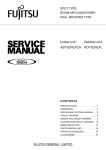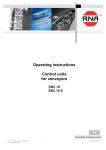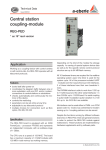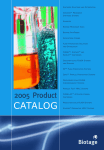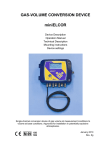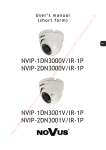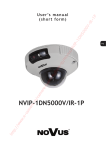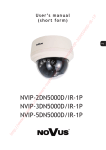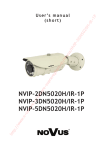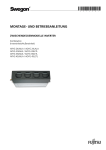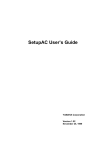Download USER MANUAL - IMPROMAT KLIMA
Transcript
Accessory of ATW-C-INV module USER MANUAL ATW - Touch panel ATW - SW APPLICATION ATW-SW program and its modification installed in touch display of ATW – Touch Panel are intended for usage, setting and monitoring of heating and cooling equipments via inverter outdoor Fujitsu unit and are equiped with inteligent controlling ATW-C-INV module. APPLICATION OPTIONS - Heat pumps air to water Chillers Cooling and heating system with AHU units with exchangers for direct evaporating of refrigerant Systems of technological cooling with application of industrial evaporators INSTALATION ATW-SW program: 1. 2. 3. 4. 5. Create separate folder in that PC where the program is started up (for example in folder Documents, Program Files etc.) and copy there the file InverterV2.exe. Create shortcut of this file on desktop. At the first start up of program the info message is appeared: Application key is not correct in InverterV2.ini. Please contact your distributor. Application ID is xxxxxxxxxxx Send this ID to your distributor by email and he will generate the Application Key. Then close this message. Insert the code sent from your distributor to appropriate place in InverterV2.ini file which was created in program folder during its first start up. Save the modified InverterV2.ini. Upgrade of ATW-SW program: In case of the new program version availability the upgrade is possible. The old InverterV2.exe file in program folder can be replaced by the new one without generation of the new code and modification of InverterV2.ini. ATW-Touch panel: Program is already installed in contoll panel. Program upgrade: In case of the new version program availability, please, contact your distributor. WAY OF CONTROL Function possibilities of both controllers are identical except of minor differences stated by the used display equipment or the way of its control. In the text possible differences will be mentioned. ATW-SW is controlled by the mouse when the cursor is placed on the approriate controlling element and selected option is confirmed by the left button. ATW-Touch panel is controlled by finger touch on the approriate displayed controlling element, option is confirmed by the colour change. STARTUP AND TERMINATION OF CONTROLLER PROGRAM STARTUP: - ATW-SW is activated by tapping the icon of ATW-SW program. ATW-Touch panel is usually supplied directly from the controlling equipment, so it is activated automaticly after equipment supply is switched on. TERMINATION: - ATW-SW: close the screen of the program. - ATW-Touch panel: power supply switch-off Description of controlling and indication elements – Home screen After program startup the preliminary Home screen is appeared. This one will provide you with basic information about system operation. This screen can be entered also from other section of the program by the button Information box about „System status“ Program version Buttons to correct Indoor temperature Buttons of manual control: Time of the system Enter „Detail“ screen“ Enter preliminary screen Enter „Graph“ screen User section „Monitor“ Enter setting Systém datas )* Graph saving )* )* at ATW-SW, only Buttons of manual control: „Start“ switching on from the standby status „Stop“ switching off in the standby status Correction of indoor temperature „Adjust temperature“. By these buttons it is possible to change setting of the indoor temperature stated by the thermal curve. Temperature shift is presented by the graphical scroll bar. ATW Panel 1.14 11:29:06 System information: Version of the software program Time of the system – identical with the set time in PC Indication of the „Indoor temperature“ (ETS-B sensor) Indication of the „Outdoor temperature“ (ETS-H sensor) Graph printing )* Description of controlling and indication elements – screen Home box „System status“ Information box „System status“ provides basic information about immediate status of the system through graphic symbols: „Heating“ mode is set „Cooling“ mode is set Automatic defrosting of outdoor unit in heating mode Compressor is running Compressor stops Program is in mode of heating of heating water by the heat pump Heating of heating water by additional source – lower step Heating of heating water by additional source – higher step Heating of DHW by heat pump Heating of DHW by the heater in tank Current regulation request for compressor output in % of its maximum output Mode of temperature reduction (by timer or external signal) System blocking by the external signal during high el. tarrif Description of controlling and indication elements - screen Detail By „Detail“ button box with further system information is displayed: Buttons for manual control: System information: „Cool“ system is switched in cooling mode „Heating water temperature“ (ETS-C sensor) „Heat“ system is switched in heating mode „Hot domestic water temperature“ (ETS-D sensor) „Exchanger temperature“ (ETS-A sensor) „Other temperatures“: Note: Non-active buttons are grey. Requested equithermal temperature of heating water (calculated by the regulator) Temperature of ETS-E sensor Temperature of ETS-F sensor Temperature of ETS-G sensor Note: Non-connected sensors are indicated by display of -0,1°C Description of controlling and indication elements - screen Graph By „Graph“ button the graph box is displayed. Measured system values are displayed in time section of one day in range from 00:00 till 24:00 o´clock. This button displays calendar where date of appropriate day of measurement is selected. Buttons with curve description of single parametres enable to switch off display of single graphs. Display status of appropriate curve is indicated by symbols: Curve display is ON Zo Curve display is OFF Buttons „Auto scale Y“ and „Auto scale X“ help to depress empty sections of the graph area Zoom functions: Any graph section is displayed by selection of relevant area and by pulling the mouse askew downwards from the left to do right. Return to the basic scale by pulling the mouse askew upwards from the right to the left. Graph is saved by button „Save chart“ )* Graph is printed by button „Print Chart“)* )* at ATW-SW, only Descritpiton of controlling and indication elements – screen Setup, folder Heat Button „Setup“ displays user settings for the heat pump air to water Button „Heat“ opens folder to set temperature regulation of heating water. The change of numeral parameters is made by arrows and save with „Set“ button. Parametres of equithermal regulation Switching between winter and summer mode of heating Indoor temperature limits: Heating Cooling Temperature attenuation: Heating mode Cooling mode Arrows for numeral value setting Output limit: for heating Temperature to switch-off the heat pump for cooling Saving of the set Values Indoor temperature limits measured by ETS-B sensor (if is used) for heating and cooling operations. Setting of 6 points of the equithermal regulation curve. In single boxes the requested temperature of heating water correspoding with outdoor temperature „Outdoor“ is set. Value of reduced temperature of heating water, activated by the timer (at ATW-Touch panel) or by external signal (on input ON2 of ATW-C-INV module), in case the Touch panel is not used. - Temperature attenuation in heating mode - Temperature attenuation in cooling mode Button to switch winter and summer mode of heating: - In winter program all used heating circuits are active. - In summer program only DHW heating is active. Circuit of heating water is switched off. Temperature setting of heating water for cooling mode. Output limit „Power limit“ – setting of maximum request for compressor output (in %) independently for heating and cooling modes. „Total bivalent limit“ – Value setting of outdoor temperature to turn off the heat pump function completely. Heat pumps is in standby status untill the temperature is increased above this value. Heating of the heating water under this value is ensured by the bivalent heating source. Description of controlling and indication elements – screen Setup, folder Timer Button „Setup“ displays user settings of heat pump air to water Button „Timer“ opens folder for week timer setting. Arrows of time settings for decline start and stop in active box „from“ and „to“ Button to copy the time item „from“ to „to“ area and jump to this area Button to erase the time item Timer on – Button to activate timer: active inactive )* Decline: shift of the equithermal curve by the value which is set in the box „Setup“, folder „Heat“ Description of controlling and indication elements – screen Setup, folder Water Button „Setup“ displays user settings of heat pump air to water Button „Water“ opens program folder to heat DHW Arrows to set numeral values Supply water enabled / Disabled – Button to activate heating function of DHW Set – Button to save setting. Saving is confirmed by the symbol change to Window „Temperature limit“: Temperature to start heating of DHW Temperature to stop heating of DHW „Power limit“ – limitation of maximum compressor output in heating mode of DHW „Time limit“ – limitation of DHW heating period by the heat pump. If the reqeusted temperature is not reached within this period for switching off the DHW heating, the electric heater in tank is switched on automatically. Description of controlling and indication elements – screen Setup, user setting of the system Button „Setup“ displays user settings of heat pump air to water Button to enter the user setting of the system. Afterwards the following screens can be displayed: Data, Date Time, Network Datas: Backup of the operation datas. Date Time: Setting of the system date and time. Network: Setting of network connection. Description of controlling and indication elements – screen Factory „Factory“ supports sevice setting of ATW-C-INV module. To prevent unauthorized access into this section the program is protected by the password. To acces the section „Factory“ enter the factory code 1937 and press „Unlock“. Change of the factory code Factory code can be changed according to the following procedure: Press the button „New pin“ and by the title „Insert pin“ you will be asked to enter the new code which must be confirmed by the button „Set pin“. Afterwards you will be asked to enter the code again by the notice „Retype pin“ and you confirm this by the button „Save pin“. Successfull saving of the new code is announced by the note „Pin saved“. Description of controlling and indication elements – screen Factory, folder Mode Checking sum Buttons to activate optional functions Limit regulation on (exchanger) – limit functions of ETS-A sensor (of exchanger): After the bottom or upper temperature litmit is achieved, this temperature will be kept by the continuous regulation of compressor output. Temperature defrost delay – how to terminate signal of DEF output: Inactive: 3 minutes after termination of defrosting cycle. This funcition is suitable to control heating element (for example heating cable) for heating of outdoor unit tray and drain. Active: After the temperature +20°C of the inner air exchanger is reached. It is possible to use operation blocking of the inner fan of AHU units to prevent draught during defrosting. Indoor temperature limit – activation of limit function of the ETS-B temperature sensor (inner air, heating water etc.) If this function isn´t active, it is possible to use the sensor with address B for temperature measurement and display. Zero power allowed – zero compressor output is allowed: Active: Compressor stop is allowed if the output request of internal regulation is lower than the minimum possible compressor output. Basic module setting. Non-active: Prohibition of compressor stop if the output request of the internal regulation is lower than minimum possible compressor output. Compressor si permanently running with minimum output although its output request is zero. Description of controlling and indication elements – screen Factory, folder Mode Checking sum Buttons to activate optional functions Slave mode on – Slave mode is allowed: If there are connected two or more outdoor units to one cooling or heating system controlled by the external (superior) regulation, it is possible to connect inputs ON and H/C of all modules paralelly. Units adjusted as Slave start to react on input signal 0-10V for output request up to value of 3,0 V. If the signal is 10,0 V the output request for all units is identical 100%. ON2 input enabled – activation of ON2 input: Non-active: Signal on ON2 input doesn´t effect unit operation. Active: At voltage of 230 VAC on ON input the internal regulation and outdoor unit operate standardly. At 0 VAC or input disconnection the system reacts in accordance to the actual setting of the module mode: 1. Micro mode: attenuation – shift of equithermal curve by the value of set attenuation (possibility to control the attenuation for example through an external timer), 2. Other modes: Stop of the unit (for example by high tarrif of electricity). Version AOYR / AOYA, Version AOYA / AOYD – setting of communication version of the module: X X AOY V X AOYR X V AOYD V V AOYA In High Power and AOYG modules this function does not influence to module setting by no way. Description of controlling and indication elements – screen Factory, folder Limits Exchanger temperature limit Temperature limit of ETS-A sensor which is placed on the inner exchanger. Regulation period Time constant of the temperature regulation is common for all controlled temperatures of internal controller. Length of indication cycle (approx. 7.5 s), multiplied by this time constant gives the time required for one capacity step. Description of controlling and indication elements – screen Factory, folder ModeV2 Checking sum Buttons to activate optional functions Heating water regulation – equithermal regulations is allowed. Temperature of heating water sensored by the ETS-C sensor depends on the temperature of ambient air which is sensored by the ETS-H sensor in accordance to the setting of equithermal curve (see the screen Setup, folder Heat). Supply water enabled – function of DHW heating is allowed. For this function ATW-EXP expander module must be added to the heat pump. Bivalent enabled – additional heating source is allowed: - Non-active: Additional source is not allowed. - Active: Additional source is allowed. At the same time the setting „Total bivalent limit“ is activated on Setup screen, folder Heat. Output ON – pump mode (V2+ only) – setting of the circulation pump control which is connected to the module output ON: - Non-active: Output ON is active only if the compressor is running. - Active: Output ON is active immediately after the software command Start, no matter if it is allowed to run by input ON. Output ON is active until the software command Stop is sent. The flow-switch contact must be connected in serial to input ON. Description of controlling and indication elements – screen Factory, folder ModeV2 Checking sum Buttons to activate optional functions Software control – software control is allowed. Non-active: Software control Start/Stop and Cool/Heat operations by RS-232 line are prohibited. Module can be controlled by ON and H/C inputs. Message „SW controll prohibited“ is appearaed on ATWD control panel display. Active: Start/Stop and Cool/Heat can be controlled by software through RS-232 line. Capacity request on the ON input must be different from zero. At zero request compressor is stopped immediately (emergency stop). If 0 VDC is on H/C input, then Cool/Heat operation can be switched by software. At voltage of 10-12VDC on this input, the system is permanently in heating status and it can not be switched to cooling. Power on state = run – This is information only, there is shown the last status of the module prior the supply is switched off. Never change! Power on mode = heat – This is information only, there is shown the last status of the module prior the supply is switched off. Never change! Micro mode – activation of heat pump function in minimum configuration without usage of ATW-EXP expander: - single-step control of additional heating source, only (by ERR output on ATW-C-INV module) - without control of HDW heating - change of the function input ON2 from blocking to decline (see the screen Factory, folder Mode: ON2 input enabled) Description of controlling and indication elements – screen Factory, folder Setup Temperature sensors ETS To ATW-C-INV module there can be connected 1 up 8 digital temperature sensors ETS. Sensors are connected to terminals TH and (GND) in the right part of the terminal box. To terminals on the module it is possible to connect 2 sensors at maximum, to connect higher number of sensors the separate terminal box is necessary to use. Note: If is used ATW-EXP expander, you can connect up to 6 ETS sensors through a terminal on it. ON ERR 1,6A 0,4A DEF 0,4A ON2 N C L ON DEF ERR 1,6A 0,4A 0,4A ETS-H ETS-C ETS-B ETS-A ETS-A white L ETS-B C shield ON2 N In case more than one sensor ETS is connected to the module, it is necessary to assign individual address in the range from A to H to each of them. Sensors Addressing (ATW-SW, only) To address sensors use the ATW-SW software and connecting ATW-Cable. The following rules must be kept during addressing: - During function „learning“ there must be connected only one sensor to the module. - One ETS sensor, which is part of the module packing, is displayed as sensor with address A even that does not have any assigned address. If we want connect one or more other sensors to the module, it si necessary that also this original sensor must be „learned“ to the address A. - ATW-C-INV modules AOYA, AOYD and HP types must be connected during setting by ATWSW to the outdoor unit or to the simulator ATW-SIM. Module AOYG type must be connected to the appropriate outdoor unit or to the simulator ATW-SIM-AOYG. Description of controlling and indication elements – screen Factory, folder Hardware, subfolder Learn (ATW-SW only) Procedure of sensors addressing: 1. The module to which further sensors will be assigned must be connected by ATW-Cable with PC (included installed ATW-SW program) 2. Start ATW-SW program and open the folder „Factory“ (with code 1937). 3. Open the window „Learn“ in folder „Hardware“. 4. Only that temperature sensor you want to assigne must be connected to the terminals of the module. 5. Click five times the mouse cursor on the position button where the sensor should be assigned. 6. As soon as the button „Learn now“ is activated press it. 7. On the relevant position the actual temperature of the assigned sensor is displayed. 8. Disconnet assigend sensor, connect another sensor which you want to activate and repeat the procedure. 9. After all sensors are assigned connect all modules sensors and check if their values are displayed on proper positions. Description of controlling and indication elements – screen Factory, folder Hardware subfolder FD (Factory default) Buttons to setting the type of communication (AOY, AOYR, AOYA, AOYD): Here you can set the desired type of communication in accordance with the compatibity table of outdoor units. Button Test: It is used for testing in the factory, only. NEVER USE! Description of controlling and indication elements – screen Factory, folder Hardware subfolder FD (Factory default) Setting AOYG modules: - In 1.24.0 program version: There must be set „Capacity“ and „Model“ values in accordance with following table: Outdoor unit Model Capacity AOHG07LEC 52 24 AOYG09LEC 52 40 AOYG12LEC 52 64 AOHG14LEC 4 80 AOHG07LUC 40 24 AOYG09LUC 40 40 AOYG12LUC 40 64 AOYG14LUC 40 80 AOYG09LTCA 40 40 AOYG12LTCA 40 64 AOHG18LFC 36 112 AOYG24LFL 36 160 AOHG30LFT 36 208 - In 1.27.0 program version: Here directly select the appropriate model. Setting by table is also possible.





















